Look & Feel
The heavily modified KDE theme strongly personifies PCLOS. But most of its elements and layout remind of its mother Mandrake (now Mandriva). The theme is no stranger to all of us who have tried/used PCLOS. The bluish theme is inviting and soothing and at the same time characteristic of a unique distro. The selling points of the distro, the PCLOS control centre, synaptic package manager and the KDE control centre are neatly displayed on the "quicklaunch" bar. The menu is old KDE style instead of the kickoff menu which I prefer. The system settings are also as expandable trees (just like KDE3) instead of icons which is the norm in many other distros.


Applications and Multimedia
The choice of applications is very apt in my point of view. For example, Imagemagick is installed by default in the graphics category , DVD slideshow maker is installed in video, and system cleaner and unncessary file cleaner are installed in file tools category. These are programs which one does not use often but they are very important for productivity and maintaining the system. The default install took around 2.6 gb. The full set of KDE games are installed by default. Interestingly, Wally the desktop wallpaper changer is there. As if to mock Ubuntu's decision to drop it from the default install, Gimp is installed by default in PCLOS. Obviously, due to space constraints Openoffice is not installed by default but can be easily installed by using a shortcut from the menu.
As expected flash worked out of the box (though its a version older than in Adobe's site). Firefox played Apple trailers with mplayer plugin. In many distros just installing the right plugin does not play Apple trailer movies, you have to tweak firefox user agent to let Apple play its movie trailers on your computer. Amarok (2.2.2.90) is the default music player and Dragon handles all video files.

Conclusion
If you are looking for a Linux distro specialized for the common everyday desktop computer then PCLOS is the number one choice. Like the much advertised MacOSX, PCLOS is ready to do every fun stuff, like watch online videos, download files using torrents, do some photo editing make DVD slideshows etc., right after install. PCLOS 2010 is the first release featuring KDE 4 as default desktop. Despite using KDE 4, the PCLOS architects have managed to maintain the original and unique style of this great distro. Though KDE4 series is radically different from KDE 3, an average Joe user who installs PCLOS 2010 wouldn't be able to tell the difference. I think this would greatly help in KDE 4 adoption among more and more people. I am looking forward for the final release to install on my ASUS Nova lite mini desktop at home which is currently running PCLOS 2009.










